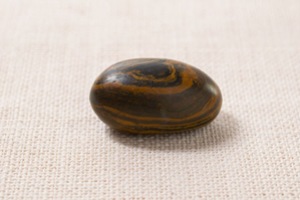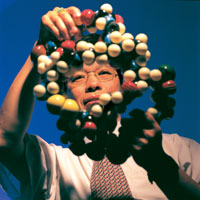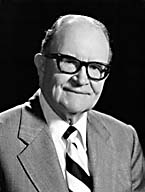When I first read this story from Elder Burton, I first thought of the translation of the Book of Mormon. A simple stone in the hands of the an average person is just that – a stone. The Lord provided a Urim and Thummim to translate the text of the Book of Mormon, and we know that at some point this was used. According to other accounts, many from David Whitmer, Joseph also used a seer stone to complete the translation. I appreciate Elder Burton’s comment that “a wise man looks at the results, not the tool”… To me, this is a valuable lesson. The Lord used Joseph Smith, an fallible human being, to produce a marvelous work and a wonder – The Book of Mormon.
 The tools used to produce the text may seem simple, but in the hands of a prophet, they were sufficient. Whether he used one stone – the seer stone, or two – the Urim and Thummim, to me makes no difference. He probably used both over time. What really matters is that the text of The Book of Mormon (something even its authors admit has flaws) brings mankind to Jesus Christ. Of this I add my witness to the many across the world that it is the word of the Lord.
The tools used to produce the text may seem simple, but in the hands of a prophet, they were sufficient. Whether he used one stone – the seer stone, or two – the Urim and Thummim, to me makes no difference. He probably used both over time. What really matters is that the text of The Book of Mormon (something even its authors admit has flaws) brings mankind to Jesus Christ. Of this I add my witness to the many across the world that it is the word of the Lord.
From Elder Burton:
 As I formerly began my organic chemistry lectures each fall at Utah State University, I used to bring to my class a small rectangular metal box. It was a breadbox, painted green, and as I brought the box into the lecture room and put it on the lectern, I would turn it so that the students could see written on the front of it, “BREAD,” and that aroused their curiosity. Every fall some student would accommodate me by asking “Why the bread, Dr. Burton?” And that would give me my cue to answer, “This is the ‘bread of life’ of organic chemistry.” This made them curious to know what I had in the box—sandwiches, cake, cookies, or perhaps actually bread for a chemical experiment.
As I formerly began my organic chemistry lectures each fall at Utah State University, I used to bring to my class a small rectangular metal box. It was a breadbox, painted green, and as I brought the box into the lecture room and put it on the lectern, I would turn it so that the students could see written on the front of it, “BREAD,” and that aroused their curiosity. Every fall some student would accommodate me by asking “Why the bread, Dr. Burton?” And that would give me my cue to answer, “This is the ‘bread of life’ of organic chemistry.” This made them curious to know what I had in the box—sandwiches, cake, cookies, or perhaps actually bread for a chemical experiment.
Later on in the lecture, I opened the box and showed them what was in it. They were amazed to see that the box was filled with tinker-toys. Yes, the box was filled with balls and sticks and tight coils of stiff wire. In fact, they looked just like baby’s playthings, and when youngsters came into my laboratory and I had to amuse them, I would actually let them play with these as toys. The only difference between these toys and ordinary tinker-toys was that the balls had been painted various colors—green, red, blue, purple, black, white—and that the holes drilled in the balls were drilled at very precise angles.

Chemists use these tinker-toy units to construct models of complex organic compounds. When I wanted to lecture, for instance, on carbohydrates to show students the structure of sugar or the structure of starch or cellulose, I used these tinker-toy models to illustrate molecular structure. Or when I lectured on proteins and had to show them the structure of the amino acids or how these were put together to form protein molecules, I used these balls and sticks and pieces of wire to show how the molecule was built and constructed.
I once heard an internationally known chemist lecture to us on the structure of enzymes. He used just exactly these tinker-toys, building first one part and then another part, and putting the parts together until he finally showed us exactly the thing that he wanted to demonstrate. Now, wouldn’t it be ridiculous to criticize a chemist of such stature because he used such simple tools or to regard his ideas as childish because he used tinker-toy models to illustrate his ideas?
It is the use that determines the value of a thing—on the one hand, a child’s plaything, but on the other hand a useful tool in the hands of a highly trained, competent scientist. A wise man looks at the results—not the tool. On the other hand, the finest of hand tools, or even a machine tool, in the hands of a clumsy oaf would be valueless.
Now, speaking of tools, God did not hesitate to use simple tools wherever he had to. We are the tools of God, and God has had to use men wherever he found them and as he found them. . . .
Now remember, it isn’t the simplicity of the tool that determines its value, but the skill of the workman who uses that tool. God, I am sure, would prefer to use the most skilled, the most able, the best-trained person that he could find, but that person must be humble and he must be teachable, and he must be willing to learn something new.
Elder Theodore M. Burton, Conference Report, April 1961, pp. 126-29.
See also: A timeline for the translation of The Book of Mormon
Joseph Smith translated The Book of Mormon Plates with the Urim and Thummim
Joseph Smith translated The Book of Mormon Plates with a seer stone

No Comments
Comments are closed.